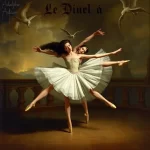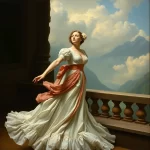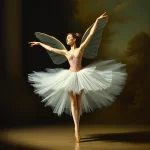Ballet: Le Diable à quatre (Adolphe Adam, 1845)

Introduction
Ballet, a classical dance form known for its grace and precision, has produced numerous masterpieces over the centuries. One such gem is “Le Diable à quatre,” a ballet composed by Adolphe Adam in 1845. This ballet, choreographed by Joseph Mazilier, premiered on August 11, 1845, at the Paris Opera. The ballet’s plot revolves around themes of love, deception, and transformation, offering a captivating narrative that has enthralled audiences for generations.
Historical Background
Creation and Development
“Le Diable à quatre” was created during a period of significant artistic and social change in Europe. The mid-19th century was marked by the Romantic movement, which emphasized emotion, individualism, and the glorification of the past and nature. This cultural backdrop influenced the creation of many ballets, including “Le Diable à quatre.”
The ballet was inspired by a French vaudeville play of the same name, which itself drew from folklore and popular tales. The collaboration between choreographer Joseph Mazilier and composer Adolphe Adam was crucial in bringing this ballet to life. Mazilier, known for his innovative choreography, and Adam, celebrated for his melodic compositions, worked together to create a ballet that combined dramatic storytelling with exquisite music and dance.
Premiere and Reception
“Le Diable à quatre” premiered on August 11, 1845, at the Paris Opera. The initial reception was overwhelmingly positive, with critics and audiences praising the ballet for its engaging plot, beautiful music, and inventive choreography. The ballet quickly became a staple in the repertoire of many European ballet companies, leading to numerous revivals and adaptations over the years.
Synopsis of the Ballet
Act I Summary
The ballet opens in a quaint village where the main characters are introduced. The central figure is a young and beautiful peasant girl named Georgette, who is married to a wealthy but arrogant farmer, Pierre. Georgette is unhappy in her marriage due to Pierre’s domineering nature. The village is abuzz with preparations for a local festival, and amidst the festivities, a mysterious stranger arrives.
Act II Summary
In the second act, the stranger reveals himself to be a mischievous devil in disguise. He offers Georgette a magical opportunity to switch places with a noblewoman, the Countess, who is also dissatisfied with her life. Georgette agrees, and through a magical transformation, she becomes the Countess, while the real Countess takes on Georgette’s identity. This switch leads to a series of comedic and dramatic events as both women navigate their new lives.
Act III Summary
The final act brings the story to its climax and resolution. The devil’s trickery is eventually uncovered, and the characters must confront the consequences of their actions. Georgette and the Countess learn valuable lessons about love, identity, and happiness. In the end, the magical spell is reversed, and everyone returns to their rightful place, leading to a joyous and harmonious conclusion.
Finale
The ballet concludes with a grand celebration in the village, symbolizing the restoration of order and happiness. The finale is marked by lively dances and a sense of unity among the characters, highlighting the themes of redemption and reconciliation.
Musical Composition
Composer’s Role
Adolphe Adam, a prolific composer of the 19th century, played a pivotal role in the creation of “Le Diable à quatre.” Known for his ability to craft memorable melodies and his skill in writing for the ballet, Adam’s music for this ballet is both enchanting and evocative. His score complements the narrative, enhancing the emotional depth and dramatic tension of the story.
Musical Themes and Motifs
The music of “Le Diable à quatre” features several recurring themes and motifs that underscore the ballet’s key moments. For instance, the devil’s theme is characterized by playful and mischievous melodies, while Georgette’s theme is more lyrical and tender. These musical elements help to convey the characters’ emotions and the overall mood of the ballet.
Famous Recordings and Performances
Over the years, there have been numerous recordings and performances of “Le Diable à quatre.” Some of the most iconic recordings include those by renowned ballet orchestras and conductors who have brought Adam’s score to life with great fidelity. These recordings continue to be cherished by ballet enthusiasts and serve as a testament to the enduring appeal of the ballet’s music.
Choreography and Dance
Choreographer’s Vision
Joseph Mazilier’s choreography for “Le Diable à quatre” is a masterful blend of classical ballet technique and innovative storytelling. Mazilier’s vision was to create a ballet that not only showcased the dancers’ technical prowess but also conveyed the narrative’s humor and drama. His choreography includes intricate footwork, expressive gestures, and dynamic group scenes that bring the story to life.
Signature Dance Numbers
One of the standout dance numbers in “Le Diable à quatre” is the Pas de Deux between Georgette and Pierre, which captures the tension and complexity of their relationship. Another notable scene is the devil’s solo, where the dancer’s movements reflect the character’s cunning and playful nature. These key dances are integral to the ballet’s storytelling and are often highlights of any performance.
Notable Interpretations
Over the years, different productions of “Le Diable à quatre” have offered unique interpretations of Mazilier’s choreography. Some have emphasized the comedic elements, while others have focused on the ballet’s romantic and dramatic aspects. These variations demonstrate the versatility of the choreography and its ability to resonate with diverse audiences.
Characters and Roles
Main Characters
- Georgette: The protagonist, a young peasant girl who longs for a better life.
- Pierre: Georgette’s wealthy but arrogant husband.
- The Devil: A mischievous character who offers Georgette a chance to change her life.
- The Countess: A noblewoman who switches places with Georgette.
Supporting Characters
- Villagers: They add to the lively atmosphere of the village and participate in the festival.
- Servants: They serve the Countess and play a role in the comedic elements of the story.
Famous Dancers
Several renowned dancers have portrayed the roles in “Le Diable à quatre” over the years. Notable performers include Fanny Elssler, who was celebrated for her portrayal of Georgette, and Lucien Petipa, who brought depth to the character of Pierre. These dancers’ interpretations have left a lasting impact on the ballet’s legacy.
Cultural and Artistic Impact
Influence on Ballet and Dance
“Le Diable à quatre” has had a significant influence on the world of ballet and dance. Its innovative choreography and engaging narrative have inspired other choreographers and composers to explore similar themes and styles. The ballet’s success also contributed to the popularity of comedic and dramatic ballets in the 19th century.
Cultural Significance
The ballet’s themes of love, deception, and transformation have resonated with audiences across different cultures and time periods. “Le Diable à quatre” has been referenced in literature, theater, and other art forms, highlighting its enduring cultural significance.
Legacy and Revivals
“Le Diable à quatre” continues to be performed and celebrated today. Major revivals and modern adaptations have kept the ballet relevant, showcasing its timeless appeal. Companies around the world have staged new productions, often incorporating contemporary elements while staying true to the original spirit of the ballet.
Iconic Productions
Historic Productions
Some of the most famous historical productions of “Le Diable à quatre” include those staged at the Paris Opera in the 19th century. These productions featured prominent dancers and innovative set designs that captivated audiences. Key figures involved in these productions included directors, choreographers, and set designers who contributed to the ballet’s success.
Contemporary Productions
Recent productions of “Le Diable à quatre” have brought fresh perspectives to the ballet. Contemporary choreographers have reimagined the choreography, while modern set and costume designs have added new dimensions to the performances. These productions demonstrate the ballet’s adaptability and its ability to resonate with today’s audiences.
Production Design
The set, costume, and lighting design in various productions of “Le Diable à quatre” have played a crucial role in bringing the story to life. Historical productions often featured elaborate sets and period costumes that reflected the village setting. Contemporary productions have experimented with minimalist designs and modern aesthetics, offering new interpretations of the ballet’s visual elements.
Critical Reception and Reviews
Initial Critical Response
At the time of its premiere, “Le Diable à quatre” received positive reviews from critics who praised its engaging plot, beautiful music, and inventive choreography. The ballet was lauded for its ability to blend humor and drama, making it a favorite among audiences.
Modern Reviews
Contemporary critics continue to appreciate “Le Diable à quatre” for its timeless appeal and artistic merit. Modern reviews often highlight the ballet’s innovative choreography and memorable music, as well as its relevance to today’s audiences. The ballet’s enduring popularity is a testament to its significance in the history of dance.
Fun Facts and Trivia
Behind-the-Scenes Stories
One interesting anecdote from the production of “Le Diable à quatre” involves a mishap during a performance where a prop malfunctioned, leading to an impromptu comedic moment that delighted the audience. Such behind-the-scenes stories add to the ballet’s rich history and charm.
Notable Performers
Famous dancers such as Fanny Elssler and Lucien Petipa have left their mark on “Le Diable à quatre” with their memorable performances. Their portrayals of the main characters have become iconic, influencing future generations of dancers.
Trivia
- The title “Le Diable à quatre” translates to “The Devil to Pay” in English, reflecting the mischievous nature of the story.
- Adolphe Adam composed the ballet’s score in just a few months, showcasing his remarkable talent and productivity.
- The ballet’s success led to numerous adaptations and revivals, making it a staple in the repertoire of many ballet companies.
Conclusion
Summary of the Ballet’s Importance
“Le Diable à quatre” holds a significant place in the world of ballet due to its engaging narrative, beautiful music, and innovative choreography. The collaboration between Joseph Mazilier and Adolphe Adam resulted in a timeless masterpiece that continues to captivate audiences.
Final Thoughts
Reflecting on “Le Diable à quatre,” it is clear that the ballet’s themes of love, deception, and transformation are universal and timeless. The ballet’s enduring popularity is a testament to its artistic merit and cultural significance. For those who have not yet experienced this ballet, watching a performance or listening to the score is highly recommended.
FAQ
What is the central theme of this ballet?
The central theme of “Le Diable à quatre” revolves around love, deception, and transformation.
Who are the main characters in this ballet?
The main characters are Georgette, Pierre, the Devil, and the Countess.
What is the most famous dance number in this ballet?
One of the most famous dance numbers is the Pas de Deux between Georgette and Pierre.
How long does a typical performance of this ballet last?
A typical performance of “Le Diable à quatre” lasts approximately two hours, including intermissions.
Are there any modern adaptations of this ballet?
Yes, there have been several modern adaptations and revivals of “Le Diable à quatre,” showcasing its timeless appeal.
Why is this ballet considered important in the history of dance?
“Le Diable à quatre” is considered important due to its innovative choreography, engaging narrative, and beautiful music, which have influenced other works and contributed to the development of ballet as an art form.





